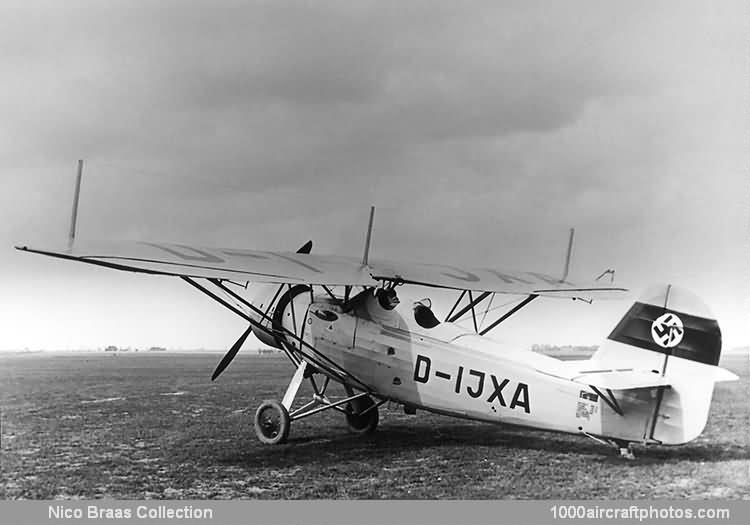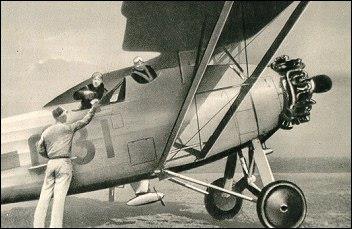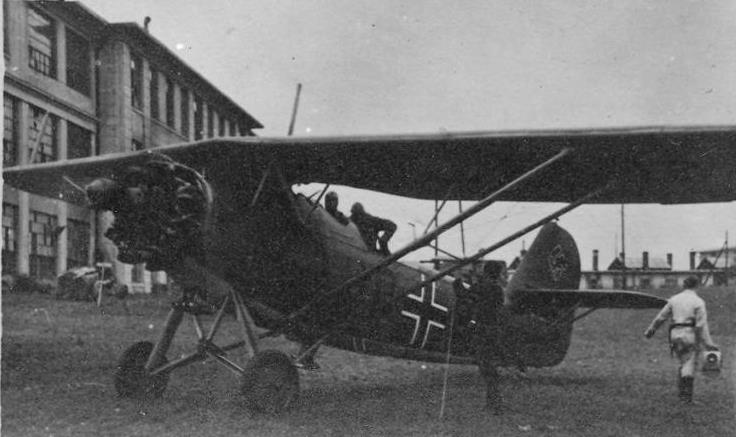| Type |
a Two seat reconnaissance aircraft |
D Two seat reconnaissance aircraft |
| Engine |
1 Siemens Jupiter VI 5.3 U |
1 Bramo SAM 322 B with 2-bladed propeller |
| Dimensions |
Length 9,4 m , height 3,4 m , span Upper 11,5 m, lower 8,8 m, wing area 31,6 m2 , |
Length 9,5 m , height 3,4 m , span 14,0 m, wing area 32,2 m2 ,
|
| Weights |
Empty 1400 kg, loaded 2170 kg , max. take off weight |
Empty 1765 kg, loaded 2300 kg , max. take off weight |
| Performance |
Max.. speed 198 km/h ,landing speed 102 km/h cruising speed , range 980 km, endurance , service 5500 mceiling , climb to 1000 m 3,0 min., to 3000 m 14,1 min. |
Max.. speed 250 km/h ,landing speed 102 km/h cruising speed , range 1000 km, endurance , service 6000 m ceiling , |
| Armament |
1 fixed and one movable machine gun |
1 7.92 mm MG 15 in rear cabin .Bombs : 20 of 10 kg |
The H.D.46 was designed as a two-seat biplane of mixed wood and metal construction with fabric covering. The upper mainplane had 10 deg sweepback, the tail plane was high-mounted and strut-braced, and there was a fixed landing gear with a tail-skid. Powered by a 450 hp Siemens-built Bristol Jupiter nine-cylinder air-cooled radial engine, the H.D.46a (registered D-1702 c/n 376) flew as the first prototype in November 1931 and was followed by the H.D.46b (D-1028 c/n 377) December 4, 1931, the latter differing in having a balanced rudder.
Flying characteristics were satisfactory but a major modification was decided on. This was the deletion of the small lower wing from the third prototype, still under construction, in order to improve the downward view. The mainplane was strutbraced to the base of the fuselage and its area was increased by 22%. Thus the He 46 was transformed into a parasol-wing monoplane, and the third prototype, designated He 46 C, incorporated also operational equipment and a single 0.311 in (7.9 mm) MG 15 machine gun in the rear observer's cockpit. Subsequently the first two biplane prototypes were converted to parasol-wing monoplanes, the He 46 A was further improved by fitting a more powerful engine, the 660 hp Siemens SAM 22B (later known as the Bramo 322B) nine-cylinder radial.
After official acceptance, production began at Heinkel's Warnemünde factory in 1933 with the He 46 C-1, which could carry either a camera or up to 440 lb (200 kg) of small bombs beneath the rear cockpit. Although Warnemünde was responsible for the bulk of production, it was necessary to bring in companies such as Fieseler, Gotha, MIAG and Siebel as subcontractors to produce the required number of aircraft within a reasonable time. The Siemens SAM 22B engines were not, however, mass-produced so easily and quality was initially sacrificed, with the result that some He 46s vibrated alarmingly.
Minor changes in the He 46 C-1 produced the He 46 D, and when this type was fitted with a NACA engine cowling it was designated He 46 E. Although this cowling improved the maximum speed by about 16 mph (25 kmh), it was rarely used in Luftwaffe service because of the engines needing constant attention. A more reliable engine, the 560 hp Armstrong Siddeley Panther, with a cowling, was fitted to the He 46 F of which a small number were built for training purposes, these were unarmed.
By 1936 the Luftwaffe's reconnaissance units were fully equipped with the He 46 and the type was offered for export. Bulgaria acquired eighteen He 46 C-2s (also noted as He 46 EBul), which differed from the C-1 mainly in having NACA cowlings, and Hungary acquired 62 He 46 E-2s (also noted as He 46 EUn, Hungary in German is Ungarn). In September 1938, twenty He 46 C-1s were dispatched for use by the Spanish Nationalists. In Spain the He 46 was nicknamed "Pava" ("Female Turkey").
When production ceased, three prototypes and at least 479 production aircraft had been produced in the following versions and quantity:
He 46 C-1:
He 46 C-2:
He 46 D-1:
He 46 E-1:
He 46 E-2:
He 46 F:
by Heinkel (200), Fiesler (12), Siebel (159)
by Gotha (18)
by Heinkel (7)
by Siebel (6)
by Mühlenbau & Industrie (62)
by Mühlenbau & Industrie (15)
From the spring of 1938, the Luftwaffe began the gradual replacement of the He 46 with the Henschel He 126 A-1, and this process was complete by the time Germany invaded France."



He 46a First prototype, two-seater equipped with a 450 hp Siemens Jupiter radial engine.
He 46b Second prototype, single-seater equipped with a 650 hp Bramo SAM 22B radial engine .
He 46c Third prototype based on the He 46b , two-seater armed with a 7.92 mm MG 15 for defense.
He 46C-1 Initial production version, based on the He 46c , able to carry 200 kg of bombs and a camera in the rear cabin.
He 46C-2 Export version of the He 46C-1 for Bulgaria, fitted with NACA engine cowling, 18 built.
He 46D-0 Six pre-production aircraft with minor changes compared to the He 46C-1 .
He 46E-1 Version with NACA engine hood, one built.
He 46E-2 Export version of the He 46E-1 for Bulgaria.
He 46E-3
He 46F-1 Unarmed observation training aircraft, equipped with a 560 hp Armstrong Siddeley Panther engine and NACA canopy.
He 46F-2 Unarmed observation training aircraft, equipped with a 560 hp Armstrong Siddeley Panther engine and NACA canopy.



